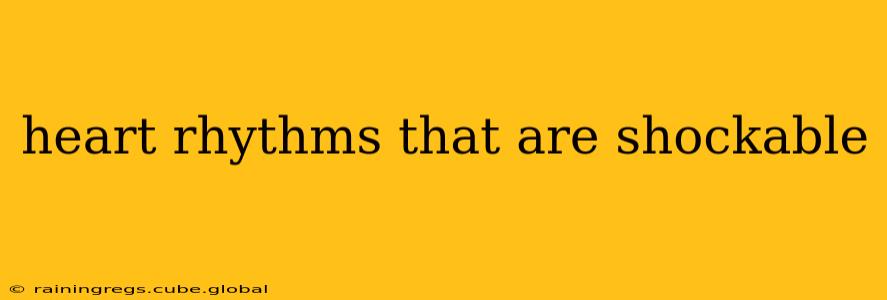Sudden cardiac arrest (SCA) is a life-threatening emergency where the heart suddenly stops beating effectively. This often results in a chaotic heart rhythm that prevents the heart from pumping blood to the brain and other vital organs. Defibrillation, a procedure that uses an electric shock to reset the heart's rhythm, is a crucial intervention in these cases. However, not all abnormal heart rhythms are shockable. Understanding which ones are and aren't is critical for effective emergency response.
What is Defibrillation?
Defibrillation is a technique that delivers a precisely timed electrical shock to the heart through the chest wall. The goal is to depolarize a large mass of cardiac muscle cells simultaneously, interrupting the chaotic electrical activity causing the abnormal rhythm and allowing the heart's natural pacemaker to resume a normal rhythm. It's a time-sensitive procedure; the quicker it's administered, the better the chances of survival.
Shockable Heart Rhythms: Ventricular Fibrillation (VF) and Pulseless Ventricular Tachycardia (pVT)
Only two heart rhythms are considered shockable:
-
Ventricular Fibrillation (VF): This is a life-threatening arrhythmia where the ventricles (the lower chambers of the heart) quiver chaotically instead of contracting effectively. This prevents blood from being pumped throughout the body. On an electrocardiogram (ECG), VF appears as irregular, disorganized waves without discernible P waves, QRS complexes, or T waves.
-
Pulseless Ventricular Tachycardia (pVT): This is a rapid heart rhythm originating in the ventricles. While the heart is beating fast, it's not pumping blood effectively, leading to a lack of pulse. On an ECG, pVT shows a rapid series of wide QRS complexes without discernible P waves. The key distinction from regular VT is the absence of a palpable pulse.
These two rhythms are characterized by a complete absence of effective heart pumping action. Defibrillation is aimed at stopping this chaotic electrical activity and allowing the heart to potentially resume a normal rhythm.
Heart Rhythms That Are NOT Shockable: Asystole and Pulseless Electrical Activity (PEA)
Several other abnormal heart rhythms are not considered shockable. These include:
-
Asystole (Flatline): This refers to the complete absence of electrical activity in the heart. There's no organized electrical activity to reset, so defibrillation is ineffective. Treatment focuses on CPR and medication.
-
Pulseless Electrical Activity (PEA): In PEA, there's organized electrical activity in the heart, but the heart isn't mechanically pumping blood. The ECG shows a rhythm (like sinus bradycardia or a slow junctional rhythm), but there's no palpable pulse. Defibrillation won't help; the focus is on CPR, advanced airway management, and medication to address the underlying cause of the PEA.
What Happens During Defibrillation?
The process typically involves:
-
CPR: Before defibrillation, CPR is performed to maintain circulation until the defibrillator is ready.
-
Defibrillator Pad Placement: Defibrillator pads are placed on the chest, ensuring good contact with the skin.
-
Energy Delivery: The defibrillator analyzes the heart rhythm and delivers a shock of appropriate energy.
-
Post-Shock Assessment: After the shock, CPR is resumed immediately and the heart rhythm is reassessed to determine if defibrillation was successful. Further shocks or other interventions may be needed.
Frequently Asked Questions
What are the chances of survival after defibrillation?
The chances of survival after defibrillation depend on several factors, including the underlying cause of cardiac arrest, the time to defibrillation, the quality of CPR, and the availability of advanced life support. Early defibrillation significantly improves the likelihood of survival.
Can defibrillation be harmful?
Defibrillation is a potentially life-saving procedure, but there are potential risks, including burns at the pad sites and chest wall injury. However, the benefits far outweigh the risks in a life-threatening situation like VF or pVT.
What happens if defibrillation is unsuccessful?
If defibrillation is unsuccessful, CPR and advanced life support measures, such as medication and airway management, will continue to be provided. The goal is to maintain blood flow to the vital organs while identifying and treating the underlying cause of the cardiac arrest.
This information is for educational purposes only and should not be considered medical advice. Always consult with a healthcare professional for any health concerns.
